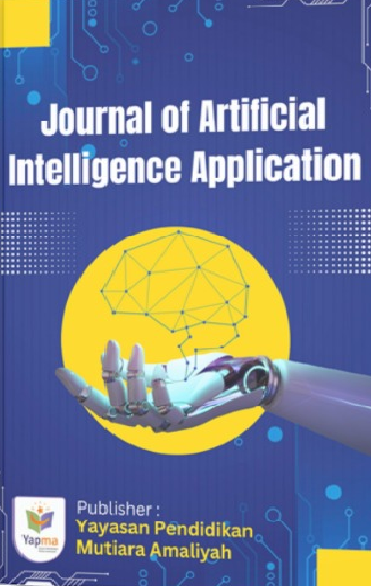ANALISIS KLASIFIKASI PENYAKIT HATI MENGGUNAKAN METODE K-NEAREST NEIGHBOR DALAM MACHINE LEARNING
DOI:
https://doi.org/10.65227/jaia.v1i1.3Keywords:
K-Nearest Neighbor, Penyakit hati, Machine learningAbstract
Abstrak: Penelitian ini fokus pada kesulitan dalam mendeteksi penyakit hati sejak dini, yang sering kali sulit dalam teridentifikasi bahkan setelah penyebarannya. Penting untuk mengetahui gejala penyakit hati sejak dini agar penderita dapat menerima pengobatan yang tepat, meningkatkan peluang kelangsungan hidup. Penelitian ini bertujuan menentukan model terbaik untuk mengklasifikasikan data penyakit hati dan mendeteksinya sejak dini, dengan menggunakan metode K-Nearest Neighbor (KNN). KNN dianggap sebagai pendekatan sederhana dan efisien dalam klasifikasi, khususnya dalam konteks prediksi penyakit hati di Indonesia. Prediksi penyakit hati menggunakan metode klasifikasi dimana dalam metode klasifikasi terdapat 3 metode meliputi (1) K-NN, (2) Naïve Bayes (3) Decission Tree yang diterapkan dalam penelitian ini. Berdasarkan 3 metode klasifikasi tersebut akan dicari 1 metode terbaik dengan nilai akurasi paling terbaik yang akan digunakan dalam proses pengolahan deploy untuk untuk prediksi penyakit hati. Dimana pengujian ini terbagi menjadi 3 yaitu 90:10, 80:20, 70:30. Penelitian ini menggunakan supervised learning dengan variabel independen seperti umur (age), pendidikan (education), dan kadar gula (glucose), serta variabel target (Tenyearchd). Dataset berasal dari kaggel.com, terdiri dari 4239 baris data dengan fokus pada 3 kolom utama dan satu kolom target, yaitu Tenyearchd. Pengujian dilakukan dengan variasi rasio data, dan hasil terbaik diperoleh pada rasio 90:10 dengan tingkat akurasi mencapai 85%%. Selain KNN, penelitian ini membandingkan metode Naive Bayes dan Decision Tree. Visualisasi data, seperti scatter plot dan diagram lingkaran, membantu dalam memahami hubungan antar variabel. Hasil pengujian menunjukkan bahwa Naive Bayes menjadi metode terbaik dengan tingkat akurasi tertinggi pada semua rasio data (85%). Kesimpulannya, penelitian ini menyoroti bahwa Naive Bayes efektif dalam mengklasifikasikan data penyakit hati untuk deteksi dini.
Abstract: This research focuses on the difficulty in detecting liver disease early, which is often difficult to identify even after it has spread. It is important to recognize the symptoms of liver disease early so that sufferers can receive appropriate treatment, increasing their chances of survival. This research aims to determine the best model for classifying liver disease data and detecting it early, using the K-Nearest Neighbor (KNN) method. KNN is considered a simple and efficient approach to classification, especially in the context of liver disease prediction in Indonesia. Prediction of liver disease uses a classification method where in the classification method there are 3 methods including (1) K-NN, (2) Naïve Bayes (3) Decission Tree which is applied in this research. Based on these 3 classification methods, we will look for the best method with the best accuracy value which will be used in the deploy processing process to predict liver disease. Where this test is divided into 3, namely 90:10, 80:20, 70:30. This research uses supervised learning with independent variables such as age, education and glucose levels, as well as the target variable (Tenyearachd). The dataset comes from kaggel.com, consisting of 4239 rows of data with a focus on 3 main columns and one target column, namely Tenyearchd. Testing was carried out with varying data ratios, and the best results were obtained at a ratio of 90:10 with an accuracy level of 85%. Apart from KNN, this research compares the Naive Bayes and Decision Tree methods. Data visualization, such as scatter plots and pie charts, helps in understanding the relationships between variables. The test results show that Naive Bayes is the best method with the highest level of accuracy in all data ratios (85%). In conclusion, this study highlights that Naive Bayes is effective in classifying liver disease data for early detection.
Downloads
References
P. N. Lhokseumawe, K. Pengantar, rahayu deny danar dan alvi furwanti Alwie, A. B. Prasetio, and R. Andespa, Implementasi Metode K-Nearest Neighbor (K-Nn) Untuk Identifikasi Ujaran Kebencian Terhadap Tokoh Politik Pada Twitter, vol. 2, no. 1. 2019.
F. Wafiyah, N. Hidayat, and R. S. Perdana, “Implementasi Algoritma Modified K-Nearest Neighbor (MKNN) untuk Klasifikasi Penyakit Demam,” J. Pengemb. Teknol. Inf. dan Ilmu Komput., vol. 1, no. 10, pp. 1210–1219, 2017.
Prabiantissa Citra Nurina, “1818-5505-1-Pb,” Semin. Nas. Tek. Elektro, Sist. Informasi, dan Tek. Inform., vol. 1, no. 1, pp. 263–268, 2021.
R. A. Siahaan, M. Nasution, M. Nirmala, and S. Hasibuan, “Model Data Mining untuk Perancangan Aplikasi Diagnostik Inflammatory Liver Disease,” vol. 06, pp. 145–153, 2021.
Elly and S. Qomariyah, “Klasifikasi Pasien Penderita Penyakit Liver dengan Pendekatan Machine Learning,” vol. 2, no. March, p. Pusporani, 2019.
E. Pusporani, S. Qomariyah, and I. Irhamah, “Klasifikasi Pasien Penderita Penyakit Liver dengan Pendekatan Machine Learning,” Inferensi, vol. 2, no. 1, p. 25, 2019, doi: 10.12962/j27213862.v2i1.6810.
Downloads
Published
Issue
Section
License
Copyright (c) 2024 Lestari

This work is licensed under a Creative Commons Attribution-ShareAlike 4.0 International License.
















